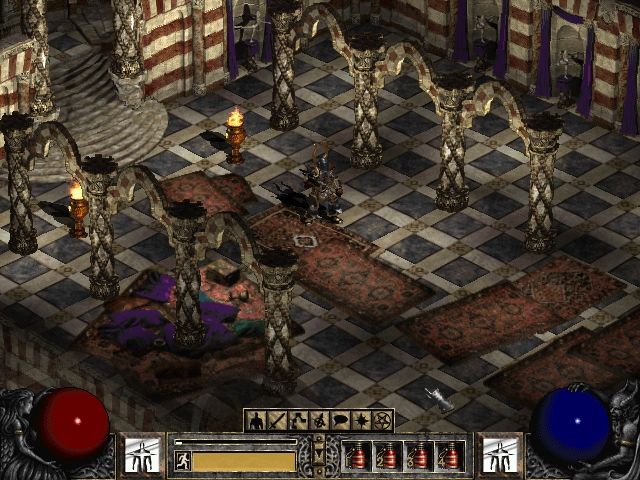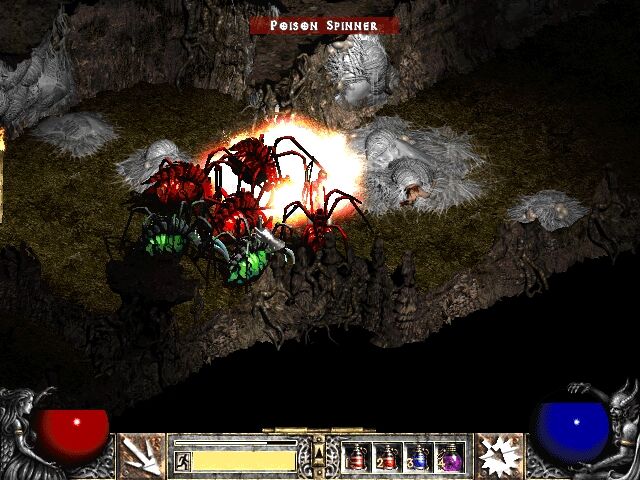Retro Replay Review
Gameplay
Diablo II’s core gameplay loop revolves around real-time hack-and-slash combat and an ever-shifting loot treadmill that keeps players coming back for “just one more run.” From the very first swing of a Barbarian’s axe or the crackle of a Sorceress’s lightning bolt, the visceral impact of each attack feels weighty and responsive. Quick-access slots allow you to chain spells or potions in the heat of battle, while inventory and stash management inject a satisfying tension into every dungeon dive.
(HEY YOU!! We hope you enjoy! We try not to run ads. So basically, this is a very expensive hobby running this site. Please consider joining us for updates, forums, and more. Network w/ us to make some cash or friends while retro gaming, and you can win some free retro games for posting. Okay, carry on 👍)
The game offers five distinct character classes—Amazon, Necromancer, Barbarian, Sorceress, and Paladin—each with its own unique playstyle and branching skill trees. Investing skill points into synergistic abilities (for example, boosting a Fireball’s damage by stacking skills in the Fire tree) deepens the strategic possibilities. Meanwhile, stat allocation into Strength, Dexterity, Vitality, and Energy forces you to weigh offensive power against survivability and resource management.
Loot drops are randomized across multiple rarity tiers—normal, magical, rare, set, and unique—providing a constant dopamine hit when a new piece of gear improves your character’s build. The Horadric Cube adds another layer of depth, allowing you to transmute low-level items into higher-tier gear or craft runewords that can dramatically alter equipment properties. This transmutation system feels like a game within the game, rewarding you for experimenting with recipes.
The four-act campaign introduces progressively tougher monsters, environmental hazards, and boss encounters, culminating in epic showdowns against the Prime Evils. As you advance through Normal, Nightmare, and Hell difficulties, the challenge ramps up alongside the quality of loot, encouraging multiple playthroughs. Cooperative multiplayer or competitive PvP modes further extend replayability, whether you’re trading hard-to-find uniques or teaming up to clear the toughest dungeons.
Graphics
Released in 2000, Diablo II’s visuals employ a dark, gothic isometric style that has aged remarkably well. Hand-painted sprites and detailed environment tilesets evoke a sense of oppressive dread as you traverse ruined forests, blistering deserts, and infernal realms. The color palette and lighting effects—like flickering torches in dungeons or the glow of magical spells—create an immersive atmosphere that still stands out today.
Character and monster animations are smooth and purposeful, with each class animation reflecting its combat role. The Amazon’s swift javelin throws look distinct from the Sorceress’s spell-casting gestures, while skeletal minions shuffle with an eerie lethargy that complements the Necromancer’s dark aesthetic. Even in areas with dozens of enemies on screen, frame rates remain surprisingly stable on modern systems.
Though the user interface might feel dated compared to contemporary ARPGs, its clean design ensures quick readability under pressure. Inventory icons are instantly recognizable, and the health/mana orbs positioned at the bottom of the screen provide clear, unambiguous feedback during the most intense fights. Cinematic cutscenes between acts are low-resolution by today’s standards but retain a certain retro charm that longtime fans cherish.
Overall, Diablo II’s graphics strike a fine balance between atmospheric grit and functional clarity. The game’s dark tone is conveyed through every pixel, and even nearly two decades after its release, the art direction continues to inspire modern ARPG developers.
Story
The narrative of Diablo II picks up directly after the original’s climax, following the Dark Wanderer—once the hero of Tristram—across the world of Sanctuary. His corruption at the hands of Diablo sets off a chain of events that see the other Prime Evils reawaken. This overarching plot drives you through four unique acts, each with its hub town, side quests, and memorable NPCs.
Act I introduces the eerie Rogue Encampment and delivers a memorable early boss fight against Andariel, the Maiden of Anguish. From there, you traverse to Lut Gholein’s sun-baked streets, Kurast’s overgrown jungles, and eventually the fiery depths of Hell itself. Each environment feels like a meaningful chapter in the epic struggle against demonic forces, reinforced by concise quest design and atmospheric dialogues with characters such as Deckard Cain and Akara.
While Diablo II’s storytelling relies heavily on environmental lore and brief in-game cutscenes, it excels in letting the world speak for itself. Clues etched into ancient walls, hidden journal entries, and the presence of corrupting influences in each region flesh out the tragic saga without lengthy exposition. This minimalist approach keeps you focused on exploration and combat, yet still invested in the stakes at hand.
The final confrontation with Diablo—and the promise of secret endgame content and ladder seasons—gives the story a satisfying climax while still leaving room for player-driven adventures. The combination of concise main quests, compelling side objectives, and rich world-building ensures that the narrative remains engaging throughout multiple playthroughs.
Overall Experience
Diablo II remains a benchmark for action RPGs thanks to its addictive gameplay loop, deep character customization, and compelling loot system. Countless modders and remasters have paid homage to its core design, but few have captured the same blend of challenge, reward, and atmospheric tension. Whether you’re a solo player forging your own path or part of a four-player party coordinating strategies, the game feels equally rewarding.
Replayability is virtually unlimited. Between the five distinct classes, multiple difficulty tiers, seasonal ladder resets, and Hardcore mode—with its permanent death—there’s always a new way to test your skills. Trading and cooperative dungeon runs breathe fresh life into each new session, and the social dynamics of item sharing or PvP duels add another dimension to the experience.
Accessibility on modern platforms has been boosted by community patches and official updates, ensuring stable online play and compatibility fixes. For newcomers, the streamlined UI and intuitive control scheme make the learning curve manageable, while veteran players can dive straight into complex builds and high-difficulty runs.
Ultimately, Diablo II offers a timeless combination of frenetic combat, compelling progression, and haunting world-building. It may show its age in certain graphical details, but its core gameplay remains as engrossing today as it was at release—making it an essential adventure for any action-RPG enthusiast.
 Retro Replay Retro Replay gaming reviews, news, emulation, geek stuff and more!
Retro Replay Retro Replay gaming reviews, news, emulation, geek stuff and more!









Reviews
There are no reviews yet.